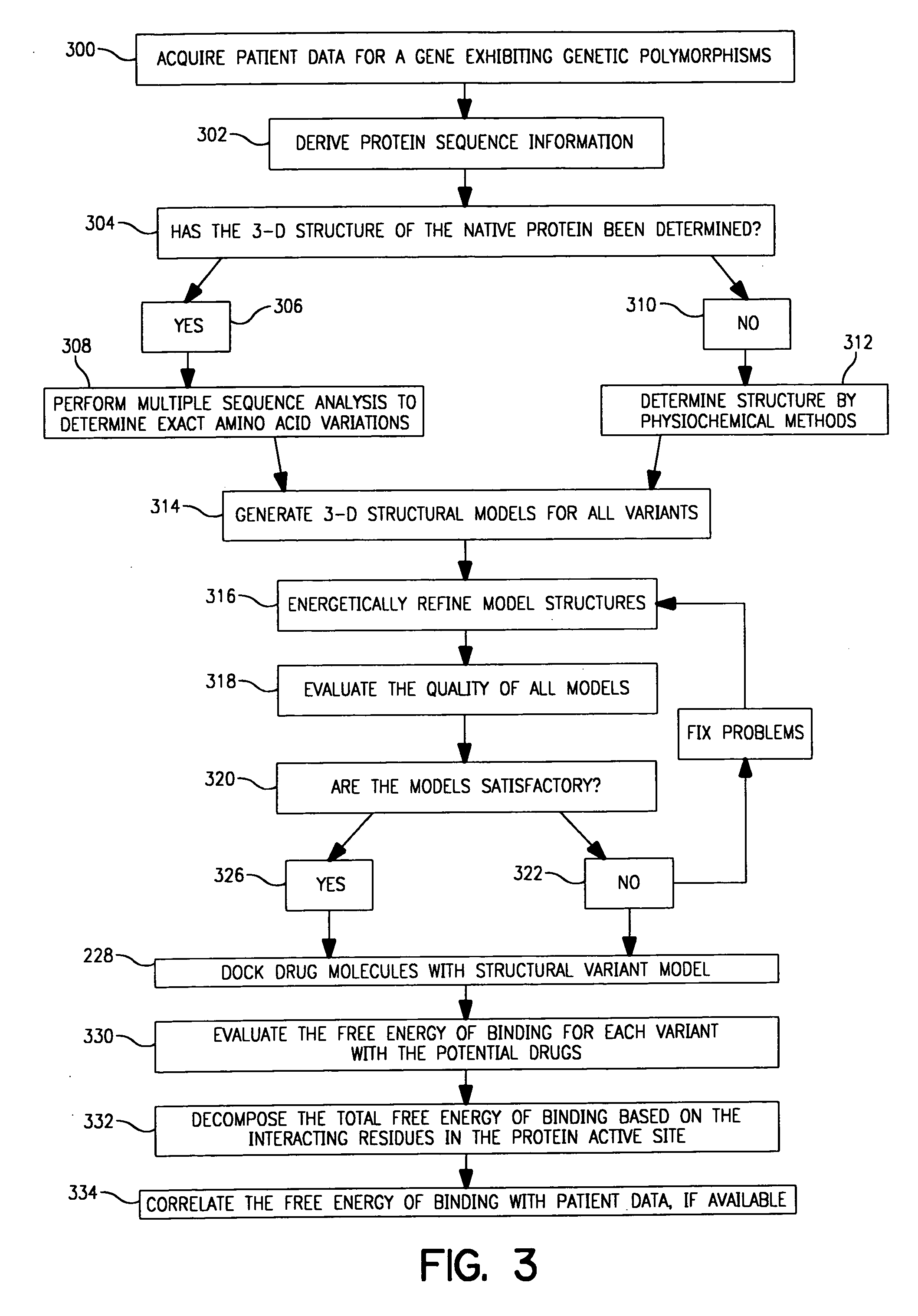Use of computationally derived protein structures of genetic polymorphisms in pharmacogenomics and clinical applications
- Summary
- Abstract
- Description
- Claims
- Application Information
AI Technical Summary
Benefits of technology
Problems solved by technology
Method used
Image
Examples
example 1
Binding Correlations of Mutant Forms of Hepatitis C Virus (HCV) Protease with Different Inhibitors
[0231] This example provides the results of a theoretical study of NS3 protease complexes with two known peptide inhibitors (see SEQ ID Nos. 1 and 2; Ingallinella et al. ((11998) Biochemistry 37:8906-8914).
Introduction
[0232] During HCV replication, the final steps of processing are performed by a virally encoded chymotrypsin-like serine protease NS3. NS3 is an approximately 3000 amino acid protein that contains, from the amino terminus to the carboxy terminus, a nucleocapsid protein (C), envelope proteins (E1 and E2) and several non-structural proteins (NS1, 2, 3, 4a, 4b, 5a and 5b). NS3 is an approximately 68 kDa protein, encoded by approximately 1893 nucleotides of the HCV genome, and has two distinct domains: (a) a serine protease domain containing approximately 200 of the N-terminal amino acids; and (b) an RNA-dependent ATPase domain at the C-terminus of the protein. The NS3 pr...
example 2
Lead Optimization by Receptor-Based Free Energy Quantitative Structure Activity Relationships (QSARs) for Tumor Necrosis Factor (TNF) Receptor Antagonist Discovery
[0270] The goal of the modeling studies in this phase was to identify binding modes and complex structures of the compounds that bind to TNF receptor type I protein in order to guide the design of new compounds. An approach that relies on docking compounds to the receptor, evaluating free energy changes of binding of the docked structures, and comparing the calculated values with experimental inhibition constants Ki of the compounds was developed. The success of the calculations was assessed by evaluating the consistency of the calculated free energy changes of binding and the experimental Ki.
[0271] The difference in free energy changes of binding between two compounds with inhibition constants Ki and Ki′ can be calculated as,
Δ(ΔG)=−kT ln(Ki′ / Ki)
where k is the Boltzmann constant and T is absolute temperature.
[0272] ...
example 3
HIV Protease Models for Drug Studies
[0281] Antiviral therapy for AIDS has focused on the discovery and design of inhibitors for two main enzyme targets of the HIV-1: reverse transcriptase (RT) and protease (PR). HIV RT is a heterodimer composed of p51 and p66 subunits. The p51 subunit is composed of the first 450 amino acids encoded by the RT gene and the p66 subunit is composed of all 560 amino acids of the RT gene. RT is responsible for RNA-dependent DNA polymerization, RNaseH activity, and DNA-dependent DNA polymerization.
[0282] HIV PR is a homodimer of two identical 99-amino acid chains. HIV PR is an aspartic proteinase that is responsible for the post-translational processing of the viral gag and gag-pol polyprotein gene products, which yields the structural proteins and enzymes of the viral particle (see, e.g., Erickson et al. (1996) Annu. Rev. Pharmacol. Toxicol. 36:545-571, Bouras et al. (1999) J. Med. Chem. 42:957-962). Despite several promising new anti-HIV agents, the ...
PUM
| Property | Measurement | Unit |
|---|---|---|
| Electrical resistance | aaaaa | aaaaa |
| Protein structure | aaaaa | aaaaa |
| Sensitivity | aaaaa | aaaaa |
Abstract
Description
Claims
Application Information
 Login to View More
Login to View More - R&D
- Intellectual Property
- Life Sciences
- Materials
- Tech Scout
- Unparalleled Data Quality
- Higher Quality Content
- 60% Fewer Hallucinations
Browse by: Latest US Patents, China's latest patents, Technical Efficacy Thesaurus, Application Domain, Technology Topic, Popular Technical Reports.
© 2025 PatSnap. All rights reserved.Legal|Privacy policy|Modern Slavery Act Transparency Statement|Sitemap|About US| Contact US: help@patsnap.com



